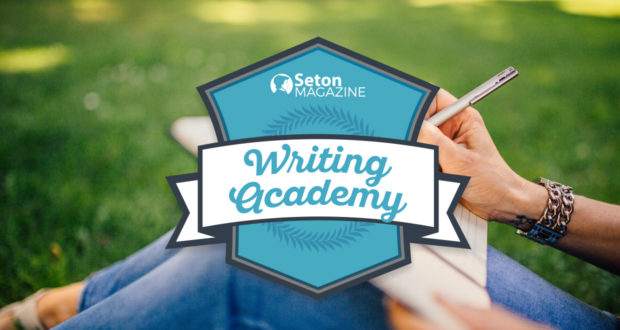Hello there, and welcome to our writing Academy!
Most of what we’re recommending in this mini ‘course’ will work anywhere online; we’ve found that the better you can follow these prompts, the better your article will do.
We’ve broken it into three sections; Beginner, Advanced, and Expert – but I bet you could get them all down pretty quickly.
Effectively, this gif is what you want folk to do when they see your article.

Using our Academy will help your readers to have this reaction to your article.
Ready? Here goes!
Part 1: Beginner: 3 Tips for an Article We'll Love
Part 1: Beginner: 3 Tips for an Article We'll Love
To be published on Seton Magazine, these three elements need to be the foundation of your article. With them, you can explore any topic you like. (See our list of ideas!):
1. Keep it Personal
Ours is a family-focused website. Our readers are looking for real stories about real people. These busy parents and families are looking for suggestions and experiences to improve their homeschooling.
Tip: Explore (wherever possible) how your theme impacted and affected you personally.
2. Include Practical Examples
Wherever possible, show our readers how something was accomplished. Don’t just tell us about something, but share the story of the events.
Draw in the readers by involving us in the situation, showing the how, why, where and who.
Tip: Show, don’t tell.
3. Toto, There’s No Place Like Home… School
As a magazine dedicated to Catholic homeschool families, we want to see content that speaks to our community. Keep your content close to home, and make it speak to, from and include homeschooling.
Our focus is on uplifting content, since many families are looking for hope and answers. Always provide a solution, or your experience to a situation to give hope, encouragement, and a smile.
Tip: Make it relate to homeschooling.
Insider Trick:
Good articles are 1) filled with facts and useful information, or 2) funny. The best are hilariously informative.
PS: Spellchecking, good grammar and clear writing are a given. ;)
Part 2: Advanced Authors: Laying out Your Article
Part 2: Advanced Authors: Laying out Your Article
Made it through Part 1? Confident to keep going? Well done!
This section breaks down the parts of an article that you need to know. There’s some good stuff here.
1. Above the Fold
You know this from your own experience; if the first few paragraphs don’t keep your attention, you’re gone.
Especially online, readers’ time is at a premium, and if they don’t immediately see the value that your article is giving them, they disappear to their happy place to keep looking for something else. Even if your article is amazing.
How to fix that? It’s an old trick that newspapers learned a long time ago. In the first few paragraphs, sum up the thrust of your article by
- Announcing the problem people face.
- Indicating who you are and your related experience.
- Explaining what is needed to solve the problem, and how your article will show them.
Getting that little practice down will automatically make your article stronger, because it will also act as a guide to you, helping you keep it personal and focused.
What also works well is to start with an anecdote showing the problem. Using a little story from your experience to illustrate the challenge folks face is a good way to warm the reader to your message and hit all three points in one go.
2. Break it Up
No one likes to read long blocks of text. Unless we are completely sold on what we’re reading – or we paid for it – we generally skip it.
How to fix that?
- Breaking up paragraphs into extremely easy-to-read, smaller paragraphs. This goes a long way toward better retention. Feature one idea per paragraph. Don’t be afraid to put important sentences on their own.
- Include subheadings to divide your content into sections. On Seton Magazine, when subheadings are included, they become a nice little menu at the top of the page. This gives our visitors a heads-up about what’s on the menu, and allows them to jump to the section they’re looking for.
3. Lists and Links
- Love using numbers.
- Whenever you can, turn your lists of ideas, themes or objects into numbered lists, or bullet points.
- They’re easy to read, and help transmit your points better.
Include highly relevant links to other articles on Seton Magazine, or good, informative articles that support your message. This is a good way to provide added value to your article, since linking provides further information and answers.
Seton Magazine will review links to 3rd party websites, and will reserve the right to include them or not.
4. Keep ’em Going!
Think of your favorite episode series, and you’ll notice that they often have multiple storylines going. Each episode will end with one of those storylines lacking resolution. You know how deliciously aggravating it can be to never have enough answers.
Well, that’s probably not an actual syndrome, but you know what I mean. Cliffhangers. How can you add that to your article?
By ending sections and paragraphs with just enough information to keep them reading.
On to the next sentence, because there are more answers, and there’s more to the story if you can keep them on the page. Do you know the easiest key to keep that going?
Asking questions. Any idea why?
Because it does two things; one: we have a love-hate relationship with questions. If the question matters to us, we can’t rest until we find the answer.
And two; it’s another way to keep the article conversational. That’s a really important aspect to keep alive in your article; the more the readers can ‘hear’ your voice, the more it feels like a friendly conversation, and less of a encyclopedia entry, or a biography.
Tip: Hook the reader’s attention by including questions, and trying to delay the resolution, or to provide the answer till the end. With every answer, try asking another question.
5. Say What?
Starting a discussion around your topic is an important way of keeping a reader engaged. Try to end each article with a question that invites the reader to sound off in the comments.
Although your article is designed to answer a question, provide a solution to a problem, or entertain with some great content, open up the floor to get people to share their experiences with your topic.
We have found that the kinds of questions that don’t work well are questions so broad that the reader would take a page to write about them.
Here are five tips:
- Try to direct the discussion to a particular point. There are plenty of articles on our site on a variety of topics, so try to stimulate folk to share with you their thoughts, their experiences, or what they think about your article.
- If you provided a list in your article, ask the readers if they can contribute to the list. That might not be the best question if there are no conceivable other options, because they may feel unable to contribute. Try to motivate their responses by offering a carrot.
- Haunt your comboxes. :) Respond to everyone quickly, honestly and with charity. You want to build up a reputation with your readers that you are listening, and eager to talk to them.
‘Like’ or upvote the comments. Especially if you have no response, show that you recognise their contribution. - Comment on articles that interest you on the magazine. Regularly sharing your thoughts is an important way to show readers that you are an active and welcome voice on the blog.
- Have an opinion, and open the door to discussion. Not every article can end perfectly or answer a question. Some topics are too diverse. Keeping in mind that this magazine is all about affirming the homeschool lifestyle and providing inspiration, gear your article toward getting a lively discussion going.
Part 3: Expert Level: Google and SEO
Part 3: Expert Level: Google and SEO
If you have mastered the previous two sections, you’re well on your way to being published on Seton Magazine. You have matched our reader’s interests, and you’ve learned to lay out your article in a clear, strong manner.
But there’s icing to this cake.
If you tailor your article properly with keywords, you will optimize it for search engines like Google. This means that months, or years from now, your article can still show up when people run searches.
If you can’t master this section, that’s ok; our editorial team will revise it for you.
But if you’re serious about being published – and read – online, then you’ll really want this tool in your skillset.
And, it’s not actually that hard.
SEO & Keywords
These two words are not as scary as they may seem. Google is now so good that you don’t have to invent crazy ways to get noticed; just write a good article.
That being said, you’ll also want to familiarize yourself with this word: ‘keywords’.
A keyword is what people use when they search for something. A bunch of keywords together makes a phrase, or a ‘long-tail’ keyword. For example: ‘good homeschool programs’, ‘funny cat videos’, or ‘how to be an awesome writer’.
If you use keywords well in your article, or find ways to use the phrases that people search for, you immediately increase your chances of being picked up by Google and offered as one of the responses to searches.
To gear your article around a keyword or phrase, you need to;
- Use a keyword finding tool to look for ideas or to search for phrases that folks are looking for.
- Include that keyword or long-tail keyword in your title, within your first paragraph, and within one of your headlines.
- Also include it a couple of times within your text, but say it in different ways, or use synonyms. Don’t spam the keyword.
Finding a Keyword
Here’s a good article to help you understand how you can empower your articles, and improve your writing online: The Content Writers Guide to SEO Keywords
Once you’ve read through that, you can use services like keywordtool.io, the Google Keyword Planner in Webmaster Tools, or the homepage of Google itself.
This video goes into plenty of detail about using SEO in your article, how it benefits you, how to use the Google keyword tool and how it gets laid out in WordPress.
You’ve reached the end! :) Well done.
Consider yourself graduated. Now that your head is spinning, go ahead and tackle your article.
Questions? Comments?
If you have any questions, don’t be afraid to ask. We’ll be happy to help you out. :)

 Seton Magazine Catholic Homeschool Articles, Advice & Resources
Seton Magazine Catholic Homeschool Articles, Advice & Resources
